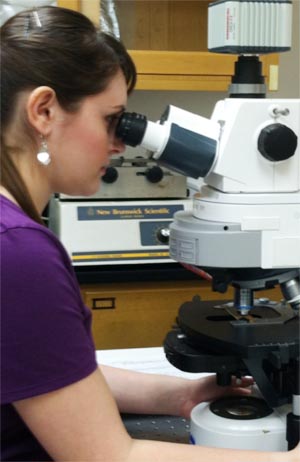

Kristina Stott
Caulobacter crescentus’ β-ketoacyl ACP synthase FabH is essential for growth and division. Therefore, Kristina Stott is studying DNA replication regulation in a FabH mutant. Kristina hypothesized that the inability of Caulobacter to produce de novo fatty acids induces a starvation condition which leads to the activation of SpoT. SpoT is a regulatory enzyme that synthesizes the alarmone ppGpp, which orchestrates an appropriate transcriptional response to survive starvation. She has found that, when blocking de novo fatty acid biosynthesis, the transcription or accumulation of cell cycle master regulators that regulate DNA replication are altered in a SpoT-dependent manner. Understanding how lipid biosynthesis integrates with the control of the cell cycle master regulators will be an important addition to our understanding of cell cycle progression. Furthermore, understanding more about how bacteria replicate may reveal novel antibiotic targets. (Advisor: Sean Murray)
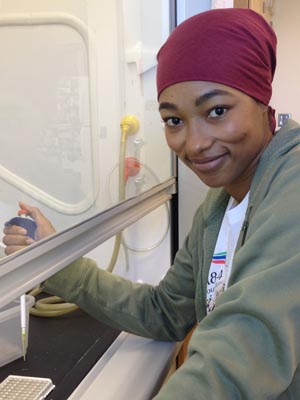
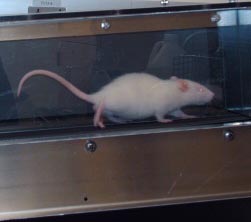
Brooke Van Kummer
Brooke Van Kummer is studying the effects of aerobic exercise on a mutant strain of rat that suffers from ataxic symptoms; kind of like the resting tremor and rigidity associated with Parkinson’s disease. She and co-workers have found that moderate treadmill exercise reduces brain cell degeneration, delays motor dysfunction, and increases the rat’s lifespan. Recently, Brooke hypothesized that since a protein called Brain-Derived Neurotrophic Factor (BDNF) is known to be important in neuronal cell survival and growth, inhibiting the action of this protein by targeting the receptor it uses (TrkB) to exert its effects ought to counter the exercise-induced neuroprotection previously found. She took mutant rats and administered the drug K252a, a known receptor activity inhibitor, or she administered a control solution. The rats were then placed on a regimen of exercise. Mutant rats receiving K252a exhibited significant declines in motor function, and examination of the brain revealed decreases in cell survival. The successful blocking of the protective effect of exercise using K252a suggests that the neuroprotective benefits of exercise directly affect a signal cascade involving the TrkB receptor. (Advisor: Randy Cohen)
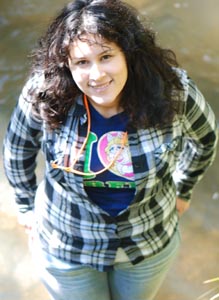
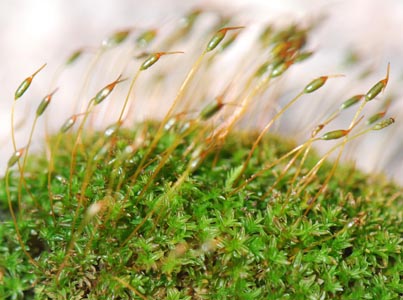
Lena Coleman
Lena Ayala Coleman is studying a grand transect of 3000 m in elevation in Sequoia National Park in terms of the community composition of the mosses. Mosses have a very different underlying biology than vascular plants. For example, mosses are able to dry out and become dormant during the summer drought of lowland California. Because of their distinctive biology, Lena does not expect moss niche relations to be similar to those of vascular plants. She has been finding that for mosses that occur in dry sites there is greater species richness down low than in the high country, whereas for mosses that occur in wet sites the reverse pattern is being found. Another results is that certain families of mosses (Pottiaceae) are very important in the lowlands, whereas other famiies (Mniaceae) are very important at higher elevations. Reproductive strategies also change. Most of the species with specialized asexual diaspores that are green occur at intermediate elevations in the Giant Sequoia zone. (Advisor: Paul Wilson)
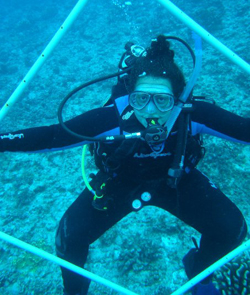
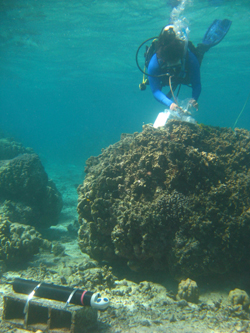
Anya Brown
Coral reefs around the world are in danger of changing from being dominated by corals to being dominated by algae. It is said that the algae outcompete the coral; however, the mechanisms of this interaction are unknown. Several hypotheses purport to explain how algae outcompete corals. (1) Possibly physical abrasion occurs when an alga rubs up against a coral and scrapes off tissue. (2) Possibility algae release noxious chemicals. (3) Or possibly algae release photosynthates that allow microbes to grow and they in turn alter the oxygen available to a coral. Anya Brown is studying how the physical force of water flow may influence the mechanism of competition and thereby the outcome of interactions between corals and algae. She has been comparing microhabitats with lower and higher water flow. In lower flow conditions, where water and chemicals are retained longer, algal turf wins more often than in higher flow conditions where chemicals are flushed away more quickly. Anya’s next steps will be to identify how the oxygen microenvironment changes in different flow speeds by placing coral-algal interactions within a flume and measuring oxygen concentrations with a miniature oxygen probe designed specifically for this purpose. Only by understanding the mechanism and what factors influence the mechanisms of competition will we be able predict what the reefs of the future will look like. (Advisor: Robert Carpenter)
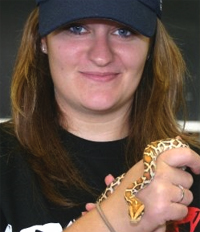
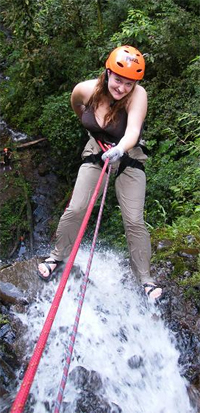
Denita Weeks
Denita Weeks studies the thermal biology of the world’s southernmost gecko, Homonota darwinii. Environmental temperature plays an important factor in the life of all organisms. In ectotherms, environmental temperature is a key component to regulating body temperature. This limits the geographic distribution of ectoterhmic species. Traditionally, geckos are known to live in warm tropical climates. Yet, H. darwinii is a nocturnal gecko that occurs across a wide distribution of Argentina, exposing it to climates ranging from warm to very cool. Denita’s study aims to synthesize physiological measurements with climatic information to characterize the current distribution and activity time for H. darwinii. Ultimately, she will use temperature predictions for the year 2100 to show how climate change could affect geographic distribution. Early data suggest that this species differs in performance ability and thermal tolerances across its distribution indicating potential shifts in distribution and activity time following climate change. (Advisor: Dr. Robert Espinoza)

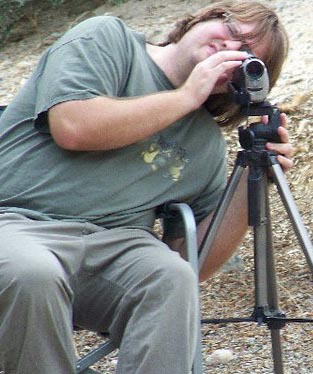
Joshua Shipp
Joshua Shipp studies heterospecific communication, especially communication between birds and mammals regarding predation risk. His study system is the California ground squirrel (Spermophilus beecheyi) and four co-occurring species of birds; Joshua is interested in how squirrels react to alarm and song calls from these four species. Field playbacks of bird call recordings have been carried out at two different locations near the Loma Linda Hills in Southern California. Results so far suggest that squirrels do indeed respond to the bird alarm calls with increased vigilance, while song calls do not provoke this same response. These results, including the possibility that song calls actually calm squirrels by representing an absence of predation risk, are an important addition to the relatively new and unexplored realm of bird-mammal communication. (Advisor: Dr. Tim Karels)
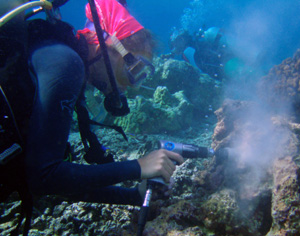
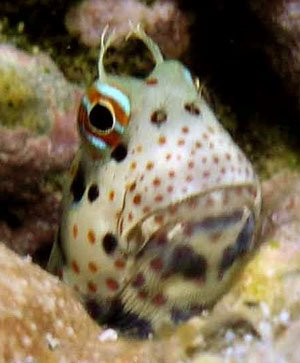
Maggie Johnson
Maggie Johnson is interested in understanding how higher concentrations of carbon dioxide in the ocean will affect growth of an important species of alga in tropical coral-reef ecosystems. Crustose coralline algae (CCA) are calcified encrusting algae that serve important ecosystem functions in coral reefs. Maggie studies how ocean acidification affects growth and calcification of one important reef building species of CCA, Hydrolithon onkodes. Her research is being done in Moorea, southern Taiwan, and Hawaii, where she has found that higher concentrations of CO2 decrease growth rates of H. onkodes. Maggie is also investigating how slower rates of CCA growth and calcification under ocean acidification conditions translate into susceptibility to grazing by herbivorous sea urchins. Maggie’s research will shed light on the consequences of carbon dioxide emissions for tropical coral reef ecosystems, and provide insight into how community composition of coral reefs may change in the coming decades. (Advisor: Dr. Robert Carpenter)

Estenia Haley
Estenia Haley is studying mating behaviors of the camel cricket Pristoceuthophilus marmaratus. Camel crickets have some interesting special features. The males have a big bend in the hind tibia, two spines on the hind femur, and tubercules on the upper dorsal region of the abdomen. There has been no previously published work on behavior in the genus Pristocethaphilus or on the functions of the males’ special features. Estenia’s observations have shown that males use their hind legs to fight other males. They also use their legs to coerce females during mating, but it seems they are more likely to coerce previously mated females compared to virgin ones. In field crickets, males attract potential mates acoustically, by using their wings to make chirping sounds. Camel crickets do not have wings, so how do they attract their potential mates? Estenia’s study suggests that the males use the tubercules to release chemical cues to attract females. These results inform the study of male-male competition and conflict between males and females over mating. (Advisor Dr. Dave Gray)

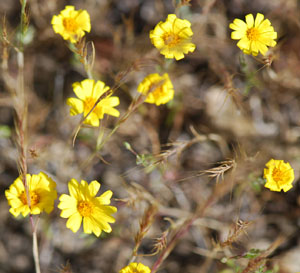
Jocelyn Holt
Jocelyn Holt is studying the endangered species Pentachaeta lyonii. As its population declines and has either low density or stray individuals not in a patch of flowers, do pollinator services also decline? Is the species in danger of imploding upon itself reproductively? Jocelyn has measured pollinator visitation and seed production in plants growing in patches of varying density and on plants in pots deployed at varying densities from a natural patch. So far, the pollination news is mostly good. The plants seem to be well served by pollinators, and the flowers appeal broadly to many species of bees and flies in the community. Probably other factors, such as competition from alien grasses, are more responsible for declines in this endangered's species reproductive output. (Advisors: Drs. Paul Wilson, Christy Brigham)
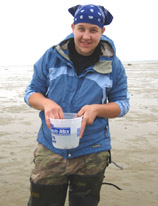
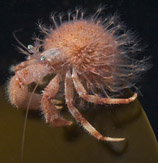
Carly Ryan
Carly Ryan works with the encrusting, colonial hydrozoan Hydractinia to study the evolution of phenotypic plasticity, that is, the ability for a genotype to produce more than one phenotype across different environments. These animals occur exclusively on the shells of hermit crabs in the intertidal mudflats of the eastern United States and have been used previously as a model system for understanding the development of animal vascular systems. Through experiments in the lab and at field sites across the Gulf of Maine she has found that changes in the environment can alter how these individuals grow – either arranging their vascular tissue as a continuous sheet or as discrete branches. These different growth forms can have wide-ranging consequences on various ecologically important traits like growth rate, metabolic efficiency, and competitive ability. Since an individual can only express one phenotype at a time, there is a complicated balance between responding morphologically to one environmental signal, like reduced oxygen, and maintaining a phenotype that is also adaptive for feeding, competing, and the colony's other concerns. Her work focuses on understanding how these selective forces interact to maintain a diversity of colony forms within populations. (Advisor: Dr. Steve Dudgeon)
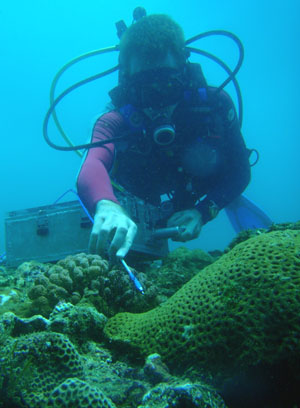
Nicholas Colvard
Nicholas Colvard studies the photophysiological and growth response of scleractinian coral to their light microenvironment. As coral cover is declining on tropical reefs, largely from thermal stresses causing bleaching events and ocean acidification degrading reef structure, macroalgae has been preempting the newly available space on the benthos. These changes in macroalgae cover over the benthos influence the spectral composition of the light microenvironments around scleractinian corals. However, little is known of the interaction this macroalgae has on the light harvesting efficiency for the corals that persist through these pressures. Colvard completed two field studies, one in Moorea, and one in southern Taiwan in the spring and summer of 2009. He found there is a difference in the spectral composition of the light environment on a heavily grazed surface compared to a substratum dominated by macroalgae. This difference in spectral quality of the benthos had a significant influence on the photophysiological response of corals incubated on artificial surfaces mimicking these environments. These findings will help scientists to better understand how corals response to the changing environment around them, as well as help to forecast the future state of tropical reefs with the threat of climate change. (Advisor: Dr. Peter J. Edmunds)
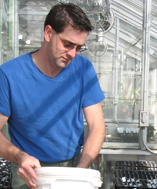
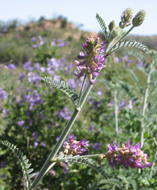
Chris Bowman-Prideaux
Chris Bowman-Prideaux is studying the population ecology of the federally endangered plant, Braunton’s milkvetch (Astragalus brauntonii). The greatest threat to this plant is habitat fragmentation and loss due to land-use changes. This plant is found in isolated populations that vary in distance with some populations isolated by more than 31 miles to the nearest known population. Bowman-Prideaux has conducted a demography study examining both vegetative and reproductive characteristics of six populations and found evidence of phenotypic differences between populations. He is currently conducting common-garden and reciprocal-transplant experiments to see if these differences are the result of plasticity or genetic divergence among the populations. This research will help to better understand this species and how to effectively manage those populations. (Advisor: Dr. Paula Schiffman)


Stella Swanson
Stella Swanson’s research is on sea urchins on the coral reefs of Moorea, French Polynesia. By controlling the growth of macroalgae, a known competitor for space and sunlight with corals, certain species of sea urchins can maintain a healthy coral reef. There are five main species of sea urchins that live on Moorean reefs, and her research is focused on determining the relative importance of each for maintaining the coral reef. It appears that there is a gradation of importance in terms of herbivory. Those species belonging to the family Diadematidaceae seem to be the most influential, grazing heavily at distances of meters from their holes. Other species such as Echinometra mathaei and Echinostrephus aciculatus are largely confined in their influence to the area within and in close proximity to their burrows. This research has broader implications in the development of management plans, which will be important tools in protecting delicate coral reef ecosystems. (Advisor Dr. Robert Carpenter)
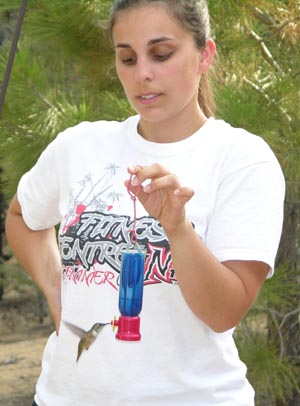
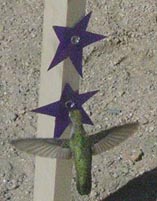
Wyndee Haley
Wyndee Haley is interested in ethology and in birds. Her supervisor works on flowers. So, she is doing her thesis on hummingbird foraging decisions. The thesis is motivated by the phenomenon that flowers adapted to hummingbird pollination have a consistent suite of characters, including the production of copious but dilute nectar, red colors, and lower lips that are small or folded out of the way. Hypotheses have long come to mind explaining this phenomenon, but past tests of those hypotheses have failed to substantiated them. For example, hummingbirds visiting feeders have a strong preference for concentrated nectar, not dilute nectar. Wyndee has constructed arrays of artificial flowers that more closely resemble real flowers (like those of Penstemon). This is allowing her to test those hypotheses under more natural yet experimental conditions. Wyndee hopes that her results can be discussed along with those from similar experiments on bee behavior. (Supervisor: Dr. Paul Wilson)

Dawn Bailey
Dawn Bailey's research focuses on the importance of predators on populations of fish within Marine Protected Areas (MPAs). She is investigating whether an accumulation of large predatory fish in MPAs causes increased mortality among juveniles, and smaller fishes, and thus alters the size structure of fish communities. Dawn works in the kelp forest communities of southern California (primarily at Catalina Island), focusing on the dominant fish-eating predator, the kelp bass (Paralabrax clathratus). Her investigation so far suggests that fish communities inside the MPA are distinguishable from those outside the MPA by the presence of both large predatory species and disproportionately few individuals of small species and size classes. The goal of Dawn's research is to provide a basis for more realistic predictions of how MPAs may affect marine fish communities.(Advisor: Dr. Mark Steele)


Ann Dorsey
Ann Dorsey is comparing the physiological ecology of nine races of Dudleya (right photo), a genus that has radiated into a large number of species in southern California. Some of the forms Ann is studying are listed as endangered species and are restricted to a few coastal sites, whereas others are common at many local sites. The races differ in life-history traits such as the propensity to flower the first year (rare ones) or to grow large before flowering (common ones). Ann is going on to test for differences in photosynthesis and growth through the seasons at inland and coastal sites and depending on whether she provides supplemental watering or not. (Supervisor: Dr. Paul Wilson)


Chris Chabot
Chris Chabot employs genetic markers to determine the level of connectivity among globally distributed populations of the tope (Galeorhinus galeus) (right photo)- a medium sized shark listed as vulnerable by the IUCN. Until recently (1946-1994), California tope populations were considered to be declining due to historic overfishing. However, more recent observations indicate that populations appear to be rebounding, but with no clear indication as to the source of new individuals (local populations vs. distant populations). In order to answer this question, Chris compared tope DNA from Argentina, Australia, California, Peru, South Africa, and the U.K.. His research has shown that tope populations are not connected, therefore increasing numbers off of the California coast must be due to local population growth and not migrants from distant populations. (Supervisor: Dr. Larry Allen)
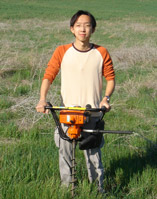
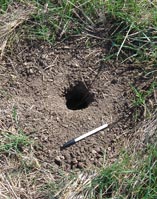
Alex Li
Lut Hang (Alex) Li is studying the effects of pocket gopher (Thomomys bottae) disturbances on grassland community composition in Santa Monica Mountains National Recreation Area. He is testing the hypothesis that there is a link between the timing and density of soil disturbance and the relative abundances of native and invasive non-native plants. Alex is simulating gopher disturbance (right photo) at different times and intensities using a soil auger (left photo). He then monitors the changes in plant species composition within his disturbed plots and compares them with undisturbed controls. The results of Alex’s study will add to our understanding of how a grassland’s natural disturbance regime can facilitate the persistence of disturbance-adapted invasive annual plants. (Advisor: Paula M. Schiffman)
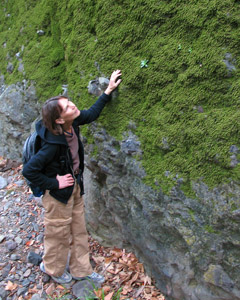
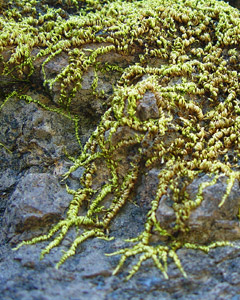
Tarja Sagar
Tarja Sagar is studying the niches of mosses (right photo) in the Santa Monica Mountains. First, she developed an identification guide to the 112 species. Then, she compared the species' microhabitat preferences and the assemblages that occur in various sites across the Mountains. Now, she is relating that information to biogeographic ranges. As part of our partnership with the Santa Monica Mountains National Recreation Area, she is also employed by the Park - she monitors rare vascular plants as her day-job. (Advisor: Paul Wilson)
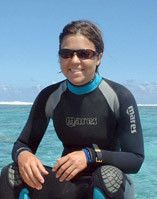
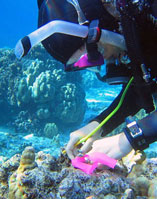
Hollie Putnam
Hollie Putnam is investigating the effects of changes in ocean temperature on coral physiology. Most of her research takes place on the island of Moorea, French Polynesia (near Tahiti), where she is conducting manipulative experiments to test the effects of daily fluctuations in temperature on common reef corals. The other portion of Hollie’s research takes place in St. John (United States Virgin Islands) and Taiwan, where she is examining the effects of thermal microclimates and fluctuating temperature on corals of different species and life stage. Hollie’s research investigates the response of corals to thermal stressors, which are a critical aspect of coral bleaching, especially in light of global climate change. (Advisor: Pete Edmunds)
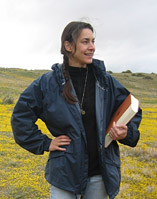
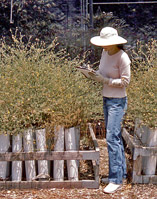
Jolene Pucci
Jolene Pucci has been studying the effects of invasive plants on a native endangered sunflower, Pentachaeta lyonii (right photo) in the Santa Monica Mountains near Los Angeles, California in association with the National Park Service. She designed and implemented field experiments to test her hypothesis that invasive plants are a cause of population declines in this endangered plant. Jolene found that three non-native plant groups reduce P. lyonii’s reproductive potential. She also demonstrated that habitat manipulations improved conditions for P. lyonii persistence. Jolene’s research provides a significant contribution for making science-based management decisions for recovery of the species. (Advisor: Paula Schiffman)
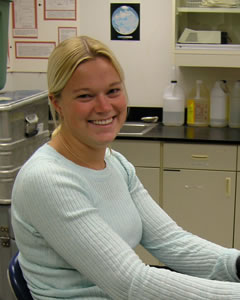

Stephanie Talmage
Stephanie Talmage conducts her research on a brown algal species, Sargassum mangarevense, in Moorea, French Polynesia. Her work addresses how water motion and herbivory can alter the distribution and responses of a tropical macroalgal species in a coral reef environment. Stephanie’s research suggests that this seaweed allocates resources differentially across abiotic and biotic gradients, and that trade-offs between algal life functions fluctuate across reef habitats. (Advisor: Bob Carpenter)
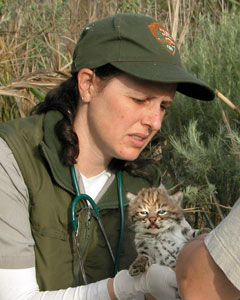
Joanne Moriarty
Joanne Moriarty is investigating reproduction in bobcats living among the small remnants of habitat within the suburban sprawl of Los Angeles. As in many US cities, rapid growth has destroyed, fragmented and pocketed much of the natural habitat, and bobcats in these areas now face many new obstacles. In partnership with the Santa Monica Mountains National Recreation Area, Joanne is measuring female home range selection and survival of kittens, to determine if bobcat populations are viable in this increasingly fragmented landscape. (Advisors: Paul Wilson and Ray Sauvajot)
